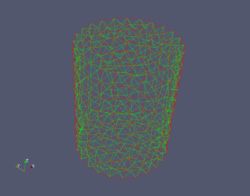

Now when I plot $g_i$, it does not look like what it should be, i.e. The B-Spline curves are specified by Bernstein basis function that has. B-Spline : B-Spline is a basis function that contains a set of control points. Then I read points (xp, yp) on $z=0$ plane and evaluate the funtion at these points with open('xpdata.txt') as g: Spline : A spline curve is a mathematical representation for which it is easy to build an interface that will allow a user to design and control the shape of complex curves and surfaces. I get the values at all vertices and then interpolate this to function f qvalues2 = numpy.loadtxt('qdata.txt')
#Gmsh specify number vertices software#
Am I doing something wrong here?Įxtract vertices of all cells, then I export these points and use another software to assign value for each point (say 3.91 for points inside sphere, 0 for points outside) coor = ordinates() I got it running without the error message, but then when I calculated the function value at points that are not vertices, it does not give me either 3.91 or 0. part int partition the mesh after batch mesh generation. If it's outside the sphere, then I assign the value 0. parametric save vertices with their parametric coordinates. mesh", I notice that the mesh file obtained doesnt' look like the standard format used by MFEM and GlVI. I extract all vertices of cells and then I assign the value to each vertex: if it's in a sphere of radius $R$, then I assign the value, say 3.91. Hello, I would like to make my own mesh with GMSH. If you just want to view what is in the file you can try gmsh. produces data. Merge data.msh Save View0 data.pos and call it with 'gmsh -0 data.1.geo' from the command line. Sometimes a STL file has too much detail for Tinkercad. But you dont need Make basically, given data in data.msh, write. Try simplifying the mesh before re-importing it. I am trying to get an interpolation function $f$ (in 3D) at all vertices of cells. Tinkercad meshes are limited to 300,000 triangles.


 0 kommentar(er)
0 kommentar(er)
